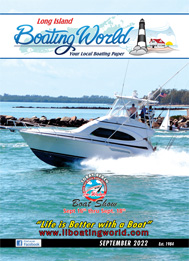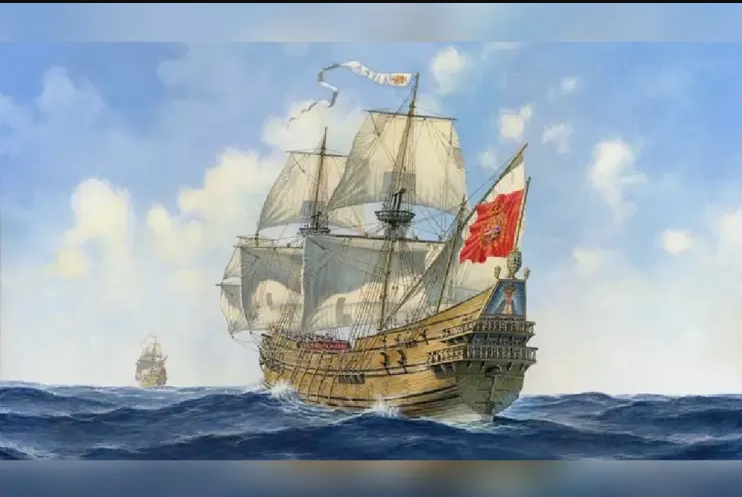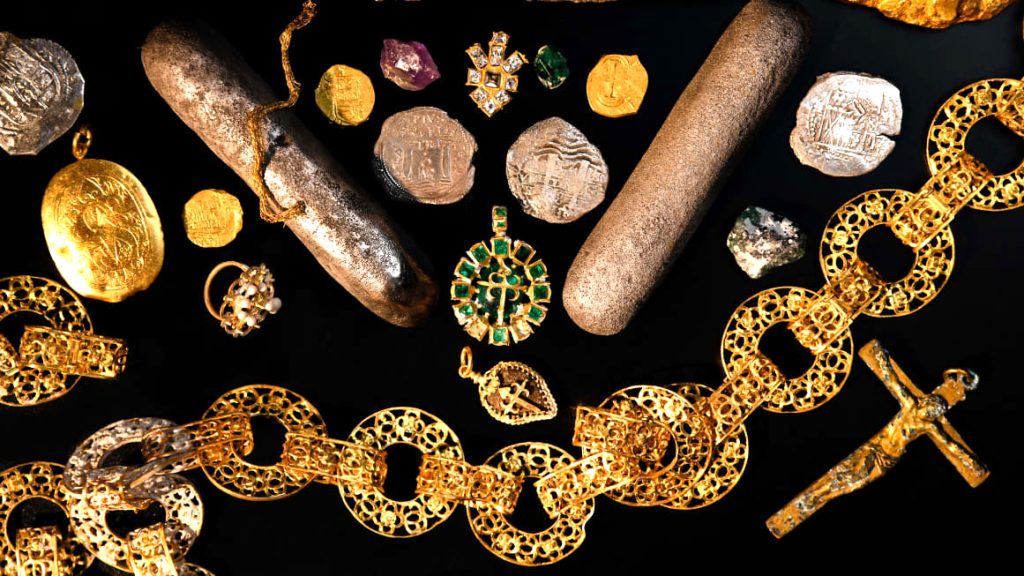
Loaded with treasure in the form of gold and silver coins, five foot six inch, a gold chain, jewels and a silver sword hilt belonging to the soldier Don Martin de Aranda end y Gusman. There was pottery, iron rings, pins, exotic Chinese plates, Mexican plates and a pearl ring, wine bottles and uniforms. The twin deck 891-ton Spanish galleon Nusta Senora de las Maravillas was transporting treasure back to Spain. Not only her normal cargo including 3.5 million pieces, but also that additional salvaged cargo of another ship that preceded, the Jesus Maria, her was sunk some months before.
An account of what happened reported in Smithsoian Magazine states “From August to December 1654, the Spanish galleon Nuestra Señora de las Maravillas (Our Lady of Wonders) waited in Cartagena, Colombia, for a cargo of silver that would never arrive. Unbeknownst to the ship’s crew, its supply vessel, the Jesus Maria de la Limpia Concepción, had sunk on a reef off Ecuador that October.
Only after the Concepción’s silver was salvaged and stowed on the Maravillas, alongside the galleons own fresh load of silver coins and bars, did the Lady of Wonders embark on its journey home to Spain. At the time, ships sailing between Europe and the Americas had to pass through the Bahama Channel, a shortcut between Florida and the Bahamas’ then-unmapped reefs. There, on January 4, 1656, the galleon lost its bearings.

Sailing as the vice-flagship of the Tierra Firme (Mainland) fleet, the Maravillas was rammed by its flagship and violently collided with a reef. The vessel sank like a stone, weighed down by its double cargo—the wreck of a wreck.”
A navigational error by her Captain caused the Maravillas to collide with another ship in the fleet. Only, 45 people survived of the 650 passengers who were aboard. The loss of the Maravillas was serious loss to Spain because at the time its treasury was in deep financial difficulty.
The wreck has been explored and much of the treasure removed over the years dating back to soon after she sank.
However, parts of the wreck were strewn across an 8-mile area of seabed and much of it was covered with as much as 20 feet of sand.
Auctioneers Daniel Sedwick and company who deals is treasure from shipwrecks stated; “The first re-discovery of the Maravillas in the 20th century was by Robert Marx and his company Seafinders in 1972, whose finds were featured in an auction by Schulman in New York in 1974. Included among the coins in this sale were some previously unknown Cartagena silver cobs of 1655 and countermarked Potosí coinage of 1649-1651 and 1652 Transitional, in addition to many Mexican silver cobs and a few Bogotá cob 2 escudos. The second big salvage effort on the Maravillas was by Herbert Humphreys and his company Marex in the late 1980s and early 1990s, resulting in two big sales by Christie’s (London) in 1992 and 1993, featuring many Bogotá cob 2 escudos, in addition to more Mexico and Potosí silver cobs and several important artifacts. The most recent sale of Maravillas finds, presumably from one of the many salvage efforts from the 1970s and 1980s, took place in California in 2005, again with a good quantity of Bogotá cob 2 escudos. The wreck area is still being searched today, but officially the Bahamian government has not granted any leases on the site since the early 1990s. It is possible the bulk of the treasure is still to be found!”

Carl Allen, entrepreneur, explorer, philanthropist and founder of Allen Exploration were determined to find the lost wreck of the Maravillas known to have sunk off the coast of the Bahamas. Using state of the art exploration equipment, Allen Exploration found the relics. Allen said, “When we brought up the oval emerald and gold pendant, my breath caught in my throat. How these tiny pendants survived in these hard waters, and ow we managed to find them, is the miracle of Maravillas.” In an interview with Fox News Digital, Allen Exploration founder Carl Allen said “that he and his team began pulling up precious artifacts in July 2020 near Walker’s Cay.
High-tech tools, plus the official permission they received from the Bahamian government to search the Northern Bahamas area — known to be a wreckage hotspot — have made for “quite amazing” discoveries, the entrepreneur said.
‘We’ve recovered thousands of artifacts,’ he said.
‘Cannons, anchors, emeralds and amethysts … We’re up to about 3,000 silver coins and 25 gold coins’.”
The artifacts of the Maravillas are now on display at the newly opened Bahamas maritime Museum. (https://www.bahamasmaritimemuseum.com) Dr. Michael Pateman, Director of The Bahamas Maritime Museum said in a press release “For a nation built from the ocean, it’s astonishing how little is understood about the Bahamas’ maritime lines. Few know that the Indigenous Lucayan people, for instance, settled here 1,300 years ago. Or that the whole population, up to 50,000 people was forced out by Spanish guns, made to dive for pearls off Venezuela, and kill of in less than three decades. There was dazzling Old World culture in the Bahamas. The Lucayans, slave trade, pirates and the Maravillas are core stories we’re sharing in the museum.”
The discovery of artifact from the Maravillas is an incredible find that furthers the undstanding of the way crew and ship operated in the era. The fact that so much more has been found and that it will be preserved in The Bahamas Maritime Museum is a testimony to the perseverance of Allen Exploration and to Carl Allen.
